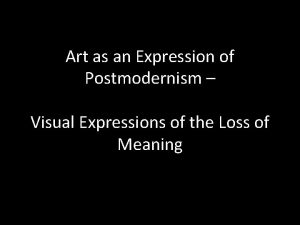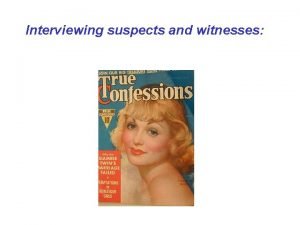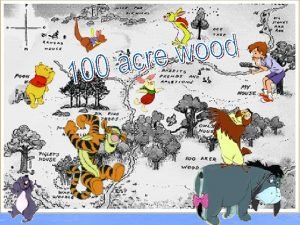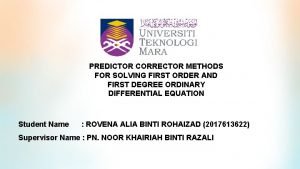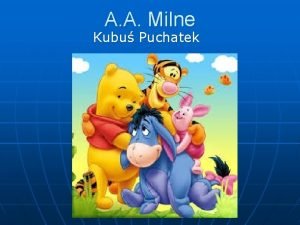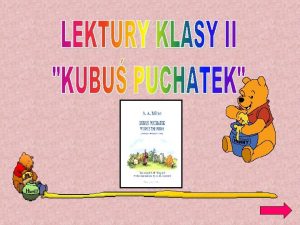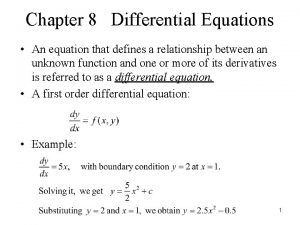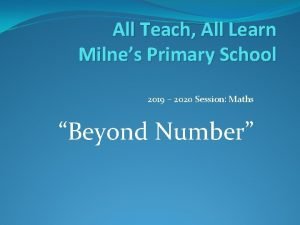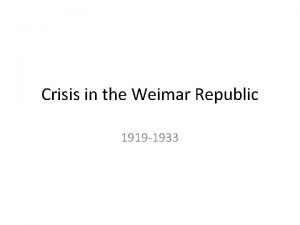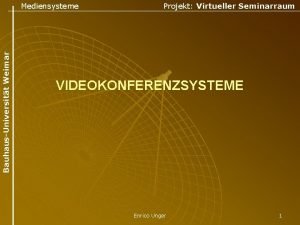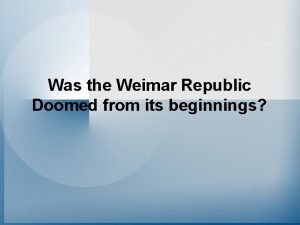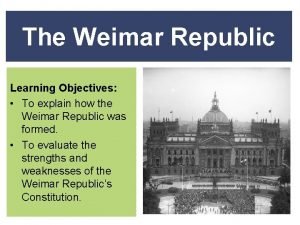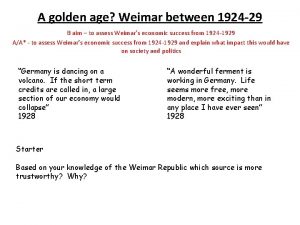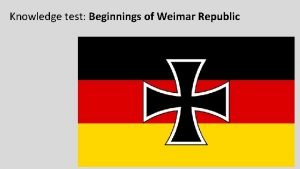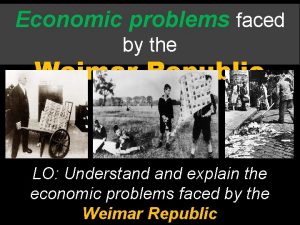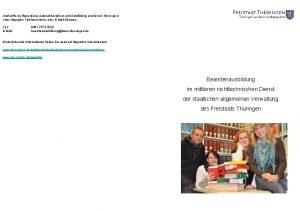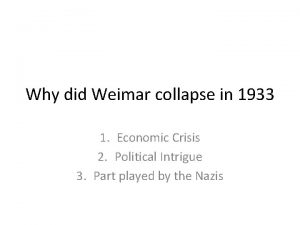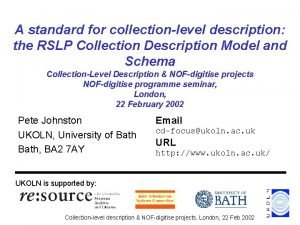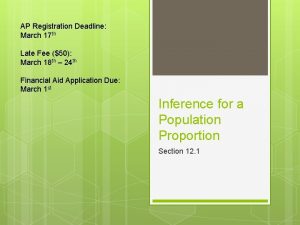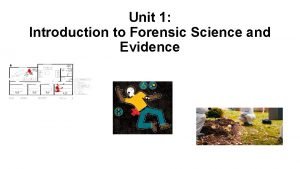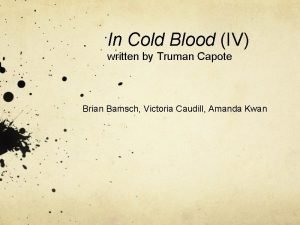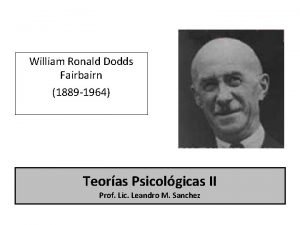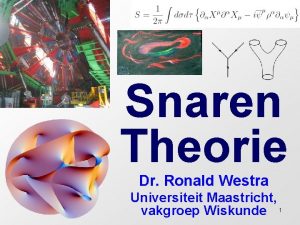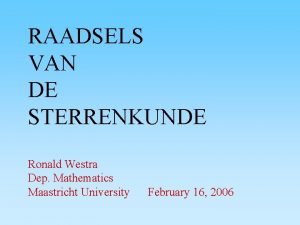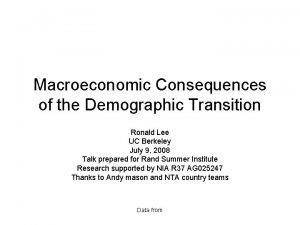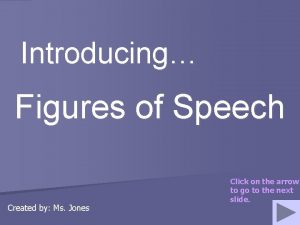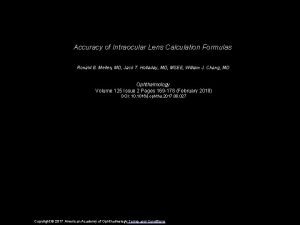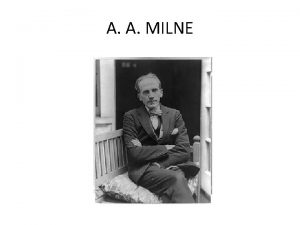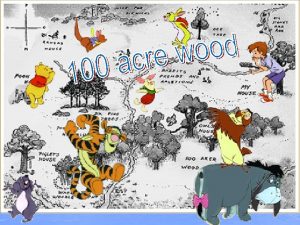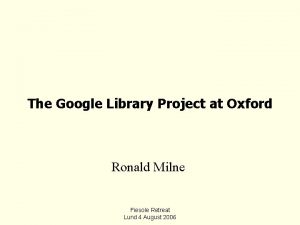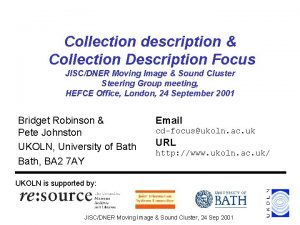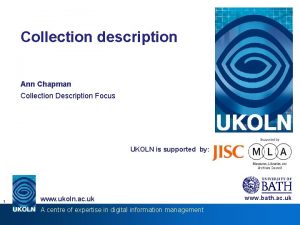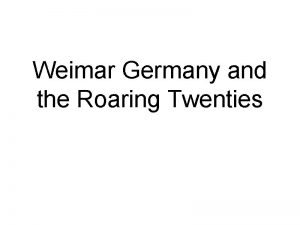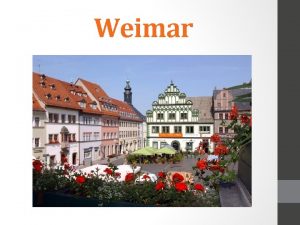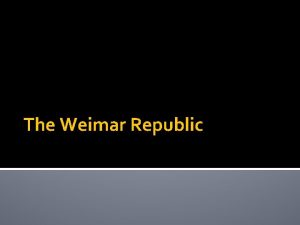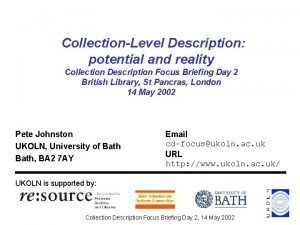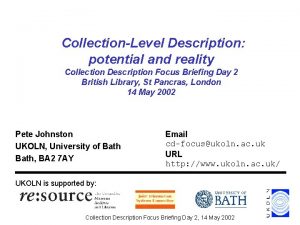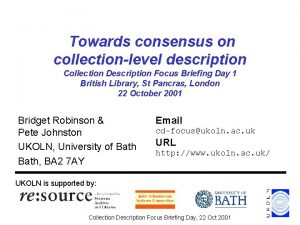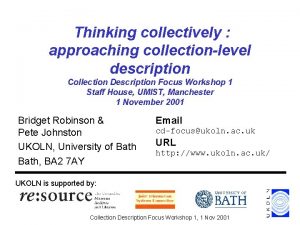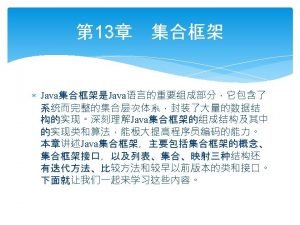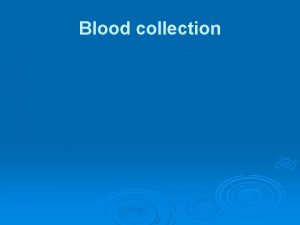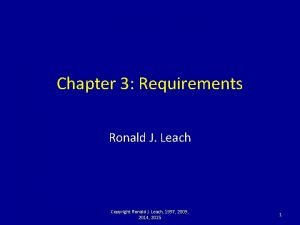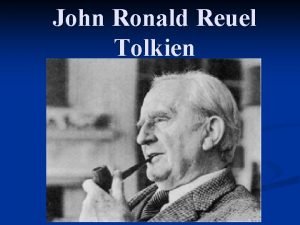Collection Description Why and Whither Ronald Milne Weimar










































- Slides: 42

Collection Description: Why, and Whither? Ronald Milne Weimar 23 November 2005

Collection Description • The concept is not new • Archivists have been compiling collection descriptions of archival collections for many years (fonds level description) • Item descriptions might be preferred in the library world, but collection descriptions also have considerable value • What is a collection?

What is a collection? The term “collection” can be applied to: • Any aggregation of physical or digital items May include manuscripts, archival material, printed books, CDs, digital surrogates of physical items, collections of ‘born digital’ material …

Research Support Libraries Programme (RSLP) • A £ 30 M funding programme for UK university libraries with research collections; financed by the four UK Higher Education Funding Councils (1998 – 2002) • Promoted collaborative work among research libraries, mainly within higher education but also with the national libraries and other libraries with research collections • Attempted to promote a holistic view of library and archive activity throughout the UK • Funded circa 50 collaborative projects mainly dealing with traditional library materials, but in almost every case creating an electronic resource. • Outputs included: bibliographic and archival records, collection descriptions, digitised images and texts, web directories and portals

Collection description – why? • Guides to special collections already available in print form: eg Bloomfield's Directory of rare books and special collections in the United Kingdom and the Republic of Ireland

Collection description – why? • Why not put such a guide on the web? • Seemed a simple idea, but complexities soon crept in • RSLP focus groups agreed that collection level descriptions for print collections would be a good idea • Increase in inter-disciplinary academic work • Faculty focused on one particular subject may not be so well acquainted with other subject areas

Collection description – why? • General public also interested in collections • Apart from discovering the collections and checking on their content one could, for example: – Check in advance to avoid unfruitful visits to libraries/archives – Check to learn about restrictions on materials

Development of RSLP Collection Description work • Important to describe collections in a consistent and machine-readable way • Talked to archivists – made clear that we were not seeking to push out ISAD(G)/EAD • Archival profession very supportive • UK Office for Library Networking (UKOLN) had already undertaken work using RSLP and OCLC funding: Michael Heaney’s Analytical model of collections and their catalogues, available through: http: //www. ukoln. ac. uk/metadata/rslp/model/ • RSLP collection description schema developed: a structured set of metadata attributes, for describing collections in the RSLP projects (based on Heaney’s analytical model) • UKOLN developed a tool that projects could use • Collection Description Focus set up at UKOLN (June 2001 - )

RSLP Collection description model (simplified view) See: www. ukoln. ac. uk/metadata/rslp/schema See also: Powell, Heaney and Dempsey: RSLP Collection Description D-Lib Magazine September 2000. <http: //www. dlib. org/dlib/september 00/powell/09 powell. html>




Collection description gathers pace • A number of RSLP-funded projects used the schema and the tool and the RSLP schema became the emerging or ‘de facto’ standard • Adopted by the UK New Opportunities Fund for collection description within the projects it funded • RSLP fields mapped onto ISAD (G) • Schema now normally used with any SQL-compliant relational database, using a webform for data entry • (Typically) output is XML

Collection Description Projects • Various approaches: – Discipline based • [eg: Mapping Asia (Humanities and Social Sciences collections relating to Asia, the Middle East and North Africa), Backstage (Performing Arts), Cecilia (Music), EGIL (Icelandic Studies), Revelation (Theology), Genesis (Women’s Studies) – Regional • [eg: RASCAL (Northern Ireland), Mapio Cymru (Wales)] – National • [eg Cornucopia (UK)] – International • MICHAEL (Italy, France, UK)
























Collection description: some issues • Issues relating to metadata standards – considerable progress made towards standardisation (NISO draft standard) • Taxonomies/subject indexing – clear that this is necessary within a particular collection description project, but how do you conduct a metasearch when different thesauri are used in different projects? Use a common thesaurus (eg UNESCO Thesaurus)? • Decision on common name authority would also be helpful • In cross domain projects there are sometimes different emphases – museums concerned with format type, libraries with named collections – an issue? • How does one measure collection strength and collection quality? (Conspectus? i. CAS software) • How do you know what collection descriptions are available? • Collection description not necessarily embedded as core work task for print collections, therefore how does one FUND this activity?

Collection description: whither? • RSLP schema forms the basis of the Dublin Core Collection Description Application Profile (DC CD AP) • NISO Metasearch Initiative has published draft standards for trial use - largely DC CD AP, with minor differences • Accessing Collection Descriptions possible via structured network services protocols: – Open Archives Initiative Protocol for Metadata Harvesting (OAI PMH) – Search Retrieve Web (SRW) for distributed searching • UK Joint Information Systems Committee (JISC) Information Environment Service Registry Project (IESR) and National Science Foundation (NSF)-funded OCKHAM project



Ronald Milne Acting Director of University Library Services & Bodley’s Librarian ronald. milne@ouls. ox. ac. uk +44 (0) 1865 287107
 Famous painting
Famous painting Hey bye bye
Hey bye bye Milne and bull 2002
Milne and bull 2002 Alan alexander milne
Alan alexander milne Explain predictor-corrector method
Explain predictor-corrector method Dr chris milne
Dr chris milne Alexander milne
Alexander milne Melancholijny kompan kubusia puchatka krzyżówka
Melancholijny kompan kubusia puchatka krzyżówka Milne's method
Milne's method Milne's method
Milne's method Milne's primary school
Milne's primary school Weimar republic gdp
Weimar republic gdp Weimar republic unemployment
Weimar republic unemployment Enrico unger
Enrico unger Was the weimar republic doomed from the start
Was the weimar republic doomed from the start Explain image
Explain image Drehrohrofen länge
Drehrohrofen länge The golden age of weimar
The golden age of weimar Weimar
Weimar Weimar republic
Weimar republic What problems did the weimar republic face
What problems did the weimar republic face Tvs weimar
Tvs weimar Weimar germany political spectrum
Weimar germany political spectrum What was chancellor brüning nickname
What was chancellor brüning nickname Weimar golden age
Weimar golden age Republic
Republic Weimar onion market
Weimar onion market Landsat collection 1 vs collection 2
Landsat collection 1 vs collection 2 Clean collection vs documentary collection
Clean collection vs documentary collection Rslp collection description tool
Rslp collection description tool Don't ask why why why
Don't ask why why why Steve jobs, steve wozniak, and ronald wayne
Steve jobs, steve wozniak, and ronald wayne Gloria chavez and ronald flynn
Gloria chavez and ronald flynn Forensic entomology does not include _____.
Forensic entomology does not include _____. Donald cullivan
Donald cullivan William ronald dodds fairbairn
William ronald dodds fairbairn Ronald westra
Ronald westra Ronald westra
Ronald westra Ronald lee in advancing
Ronald lee in advancing Personification meaning
Personification meaning Banifilina
Banifilina Ronald adams screenwriter
Ronald adams screenwriter Dr ronald melles
Dr ronald melles
